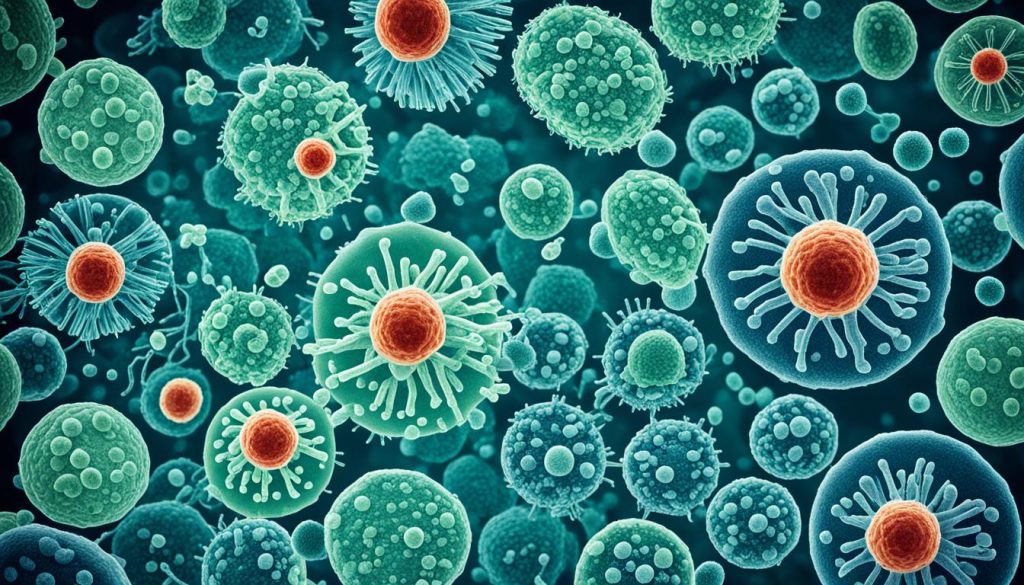A low white blood cell count can be concerning, but understanding the most common reasons behind it can help shed light on the situation. Several factors can contribute to a low white blood cell count, also known as leukopenia. By exploring the causes, symptoms, diagnosis, and treatment options, you can gain a better understanding of this condition and how to address it.
Low white blood cell count can occur due to various reasons. Some of the most common causes include:
- Cancer treatment, such as radiotherapy and chemotherapy
- Antipsychotic medicines
- Medications used for an overactive thyroid
- Certain types of cancers, like leukemia
- Infections, such as HIV or hepatitis
- Autoimmune conditions like rheumatoid arthritis
These factors can affect the body’s ability to produce an adequate number of white blood cells, leading to a low count. It’s important to note that conditions like agranulocytosis and neutropenia can also cause a low white blood cell count.
When experiencing a low white blood cell count, individuals may exhibit symptoms such as frequent infections, high temperature, sore throat, mouth sores, fatigue, and flu-like symptoms. These symptoms can be indicative of a compromised immune system.
Diagnosis typically involves a blood test that confirms the white blood cell count, allowing healthcare professionals to assess the severity of the condition and determine appropriate treatment options.
Treatment for a low white blood cell count depends on the underlying cause. Antibiotics may be prescribed to prevent or treat infections. Stopping or changing certain medications may also be necessary. In some cases, specific treatments are employed to boost white blood cell production or address existing infections.
By understanding the causes, symptoms, diagnosis, and treatment options associated with a low white blood cell count, individuals can work closely with their healthcare providers to manage this condition effectively and take the necessary precautions to maintain good health.
Common Causes of Low White Blood Cell Count
A low white blood cell count, or leukopenia, can be caused by various factors. Understanding the common causes can help in identifying and addressing this health issue. Here are some of the key reasons for low white blood cell count:
- Cancer treatment: Certain cancer treatments like radiotherapy and chemotherapy can suppress the production of white blood cells, resulting in a decrease in white blood cell count.
- Antipsychotic medicines: Some antipsychotic medications may impact white blood cell production, leading to a decrease in white blood cell count.
- Medicine for an overactive thyroid: Medications used to treat an overactive thyroid can also affect white blood cell production and result in a low white blood cell count.
- Certain cancers: Specific types of cancers, such as leukemia, directly affect white blood cell count.
- Infections: Infections caused by viruses like HIV or hepatitis can lead to a decrease in white blood cell count.
- Autoimmune conditions: Conditions like rheumatoid arthritis, which are characterized by an overactive immune system, can contribute to low white blood cell counts.
It’s important to note that these are just some of the common causes of a low white blood cell count. There may be other factors involved, and a comprehensive evaluation by a healthcare professional is necessary to determine the underlying cause.

Evaluating the Causes
Each individual’s case may vary, and a thorough evaluation is required to pinpoint the cause of a low white blood cell count. Medical history, physical examinations, and laboratory tests play a significant role in diagnosing the underlying cause. Proper diagnosis is crucial to develop an appropriate treatment plan and manage the condition effectively.
In the next section, we will explore the symptoms and diagnosis of a low white blood cell count, shedding light on how it can be identified and addressed.
Symptoms and Diagnosis of Low White Blood Cell Count
A low white blood cell count does not always cause symptoms, but one of the main indicators is frequent infections. It is important to understand the symptoms and seek proper diagnosis to address this condition effectively.
Symptoms of Low White Blood Cell Count
- Frequent infections: Individuals with a low white blood cell count are more susceptible to infections. Common signs of infection include a high temperature, chills, sore throat, mouth sores, toothache, skin rashes, tiredness, and flu-like symptoms.
Diagnosis of Low White Blood Cell Count
If you experience recurrent infections or other concerning symptoms, it is essential to consult a healthcare professional. A blood test is required to confirm a low white blood cell count. The test measures the number of white blood cells in the blood and helps determine the appropriate course of action.

Proper diagnosis is crucial, as it allows healthcare providers to identify the underlying cause of the low white blood cell count and develop an effective treatment plan.
Treatment for Low White Blood Cell Count
Treatment for a low white blood cell count depends on the underlying cause. In many cases, antibiotics are prescribed to prevent or treat infections. Additionally, adjusting or stopping medications that may be causing the low white blood cell count can be necessary. Specific treatments may be recommended to boost white blood cell production or address existing infections. It is important to note that severe cases of infection can lead to sepsis, a life-threatening condition that requires immediate medical attention.
If a low white blood cell count is caused by medication or treatment, the healthcare provider may consider the following options:
- Adjusting the dosage or frequency of the medication
- Switching to an alternative medication
- Discontinuing the medication if possible
Please note that any adjustments or discontinuation of medication should only be done under the guidance and supervision of a healthcare professional.
In cases where the low white blood cell count is due to underlying health conditions, such as autoimmune diseases or bone marrow disorders, the treatment approaches vary. These may include:
- Medications to suppress the immune system and manage autoimmune conditions
- Growth factors or stimulants to increase white blood cell production
- Bone marrow transplant in severe cases
It is crucial for individuals with a low white blood cell count to follow their healthcare provider’s advice and treatment plan to effectively manage the condition and prevent complications.
Treatment Options for Boosting White Blood Cell Production
In some cases, healthcare professionals may recommend specific treatments to boost white blood cell production. These treatment options include:
- Granulocyte colony-stimulating factor (G-CSF) injections, also known as filgrastim, to stimulate the production of white blood cells in the bone marrow
- Immunoglobulin therapy to enhance the immune system’s ability to fight infections
- Transfusion of white blood cells or platelets
These treatments aim to increase the number of white blood cells in the body and improve the immune response.
Preventing and Managing Infections
Individuals with low white blood cell counts are at a higher risk of developing infections. Therefore, it is essential to take precautions to prevent infections. Some measures include:
- Frequent handwashing with soap and warm water for at least 20 seconds
- Avoiding close contact with individuals who are sick or have contagious illnesses
- Practicing good oral hygiene, such as regular toothbrushing and flossing
- Eating a healthy diet rich in fruits and vegetables to support overall immune health
- Ensuring food safety by properly storing and preparing food
By following these preventive measures, individuals can reduce their risk of infections and minimize the potential complications associated with a low white blood cell count.

Prevention and Precautions for Low White Blood Cell Count
Individuals with a low white blood cell count caused by illness, cancer treatment, or medication should take precautions to avoid infections. By following these preventive measures, you can reduce the risk of further complications associated with a low white blood cell count.
Avoid Close Contact with Sick Individuals
When your immune system is compromised due to a low white blood cell count, it is important to steer clear of individuals who are sick. Viral and bacterial infections can easily spread through close contact, increasing the likelihood of developing an infection.
Proper Food Storage and Preparation
Preventing food poisoning is crucial for individuals with a low white blood cell count. By practicing proper food storage and preparation techniques, you can minimize the risk of bacterial contamination. Ensure that food is stored at the correct temperatures, cook meats thoroughly, and wash fruits and vegetables before consuming them.
Regular Handwashing with Soap and Warm Water
One of the best ways to prevent infections is by maintaining good hand hygiene. Wash your hands frequently with soap and warm water for at least 20 seconds, especially before handling food, after using the restroom, and after being in a public place.
Use an Electric Shaver Instead of a Razor
Cuts from shaving can introduce bacteria into the body, increasing the risk of infection. To minimize this risk, opt for an electric shaver instead of a razor. Electric shavers provide a close shave without the risk of cuts or nicks.
Avoid Sharing Personal Items
Sharing personal items can facilitate the transmission of bacteria and viruses. To reduce the risk of infection, avoid sharing items such as food, cups, utensils, toothbrushes, and makeup. It is also important to avoid sharing towels or clothing items that may come into contact with bodily fluids.
Avoid Raw Foods and Handling Animal Waste
Raw foods, such as raw eggs, unpasteurized dairy products, and undercooked meats, can harbor harmful bacteria. It is advisable to avoid consuming such foods to minimize the risk of foodborne illnesses. Additionally, it is important to take precautions when handling animal waste to prevent exposure to potential pathogens.
Avoid Walking Barefoot Outside and Swimming in Natural Waters
Walking barefoot outside exposes you to various bacteria and fungi that can cause infections. Similarly, swimming in ponds, lakes, and rivers can also increase the risk of contracting waterborne infections. It is advisable to wear appropriate footwear when outdoors and to swim in clean, chlorinated pools.
By following these prevention and precautionary measures, individuals with a low white blood cell count can reduce the risk of infections and promote better overall health.

Conclusion
A low white blood cell count can be a result of various factors, including cancer treatment, certain medications, infections, and autoimmune conditions. It is crucial to stay vigilant of any symptoms and seek medical attention if frequent infections occur. The treatment for a low white blood cell count depends on the underlying cause and may involve antibiotics, adjustments to medications, and specific treatments to target infections or enhance white blood cell production.
For individuals with a low white blood cell count, taking precautions to prevent infections is of utmost importance. Practicing proper hand hygiene, avoiding close contact with sick individuals, and following food safety practices can significantly reduce the risk of infections. By adopting these preventive measures, it is possible to mitigate the chances of further complications and maintain overall well-being.
In conclusion, monitoring symptoms, seeking appropriate medical care, and implementing infection prevention strategies are key to managing a low white blood cell count. By working closely with healthcare professionals and adopting healthy habits, individuals can effectively navigate the challenges associated with a low white blood cell count and optimize their health outcomes.




